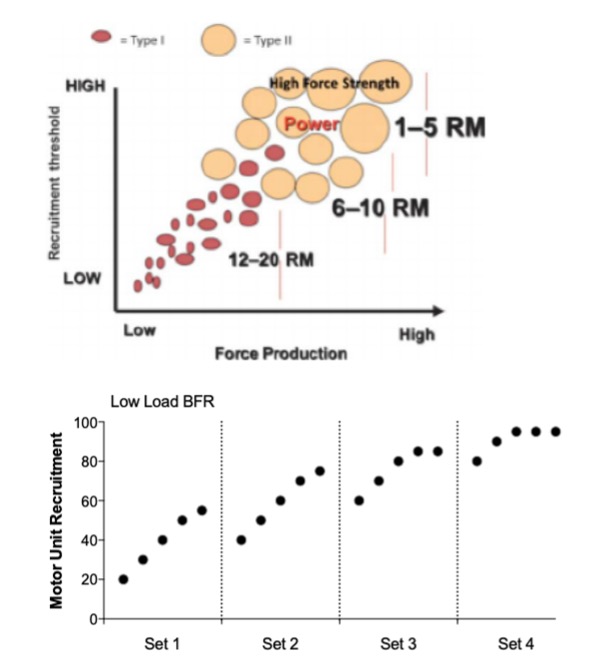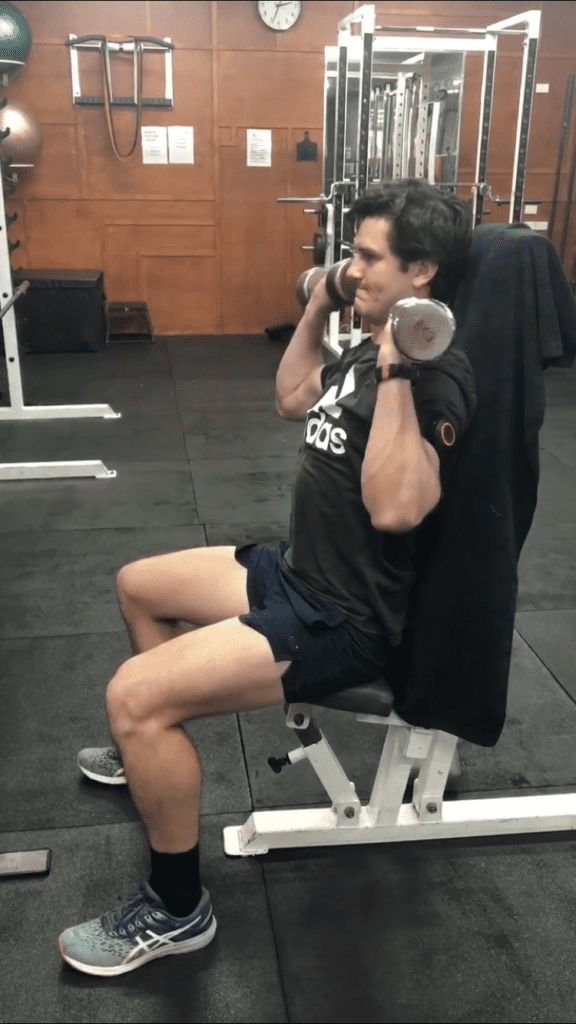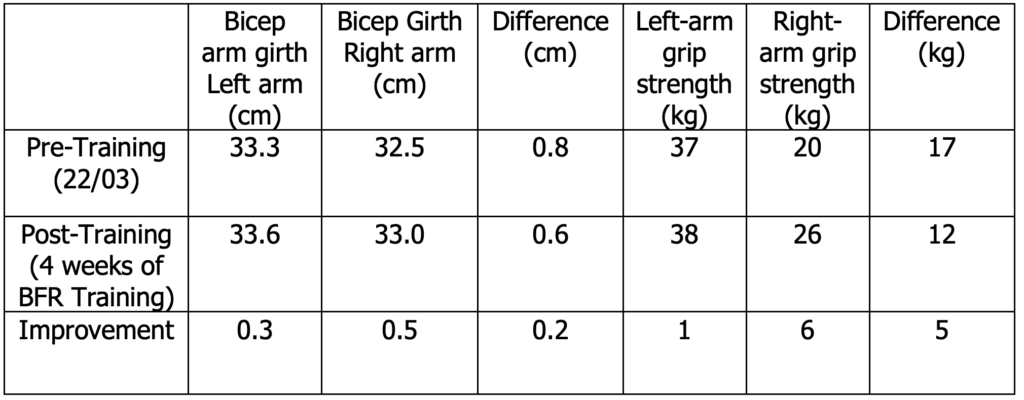How Blood Flow Restriction Can Improve Strength
Acceleration Coach Jack Clayton has done some research on Blood Flow Restriction Training. Basically, the athlete wears a cuff on the muscle being used to restrict blood flow during weight training. Generally speaking, restricting the blood flow to that muscles means you can lift less weight but still gain strength. This type of training has some applications that would be beneficial to athletes who are rehabilitating from injury or trying to gain strength during a busy in-season program.
Underlying physiological mechanism underpinning BFR training
To achieve muscular hypertrophy and strength, the body must be stressed either mechanically or metabolically. Blood flow restriction (BFR) training aims to induce muscular hypertrophy by reducing mechanical tension and increasing metabolic stress – refer to figure 1.
To achieve this, a pneumatic cuff or tourniquet is applied to the proximal region of a limb whilst performing exercise. The goal is to partially restrict oxygen delivery to the muscles distal to the cuff and occlude venous blood flow exiting the limb [1]. This results in metabolite accumulation within the muscle belly, increasing metabolic stress [2].
Subsequently, the muscle becomes fatigued quicker which lowers the recruitment threshold for type II motor units. Therefore, after multiple sets of low-load BFR exercise, type II muscle fibres are recruited to maintain force output. This leads to hypertrophic muscular adaptation at much lower loads (20-30% 1RM), compared to traditional high load strength training (60-80% 1RM) [3-6] – refer to Figures 2 and 3. This is of significance as BFR be used as an alternative training method to reduce mechanical load on the body, during periods of reduced loading (i.e., off-season) or for populations that cannot tolerate high load training (i.e., injured athletes).

Figure 1. Primary outcome of blood flow restriction training (adapted from Pearson, Hussain [2]).
It must be noted, that while research suggests that low-load BFR (LL-BFR) training can illicit similar or increased hypertrophic adaptation compared to high-load resistance training (HL-RT) [3-6], HL-RT still results in significant improvements in muscular strength compared to LL-BFR.
It is hypothesised that this is the case as LL- BFR exercise appears to induce peripheral fatigue with little central fatigue, whilst high-load resistance training HL-RT induces central fatigue and enhances neural networks [6].

Figure 2. Mechanism behind BFR Training (adapted from Pearson, Hussain [2]).

Figure 3. BFR and motor unit recruitment (adapted from Pearson, Hussain [2]).
How can BFR be used effectively at Acceleration (i.e., best rep/set ranges for LB and UB)?
Several different training protocols have been suggested within the literature. However, the two most commonly used and effective protocols for muscular adaptations are the 30-15 and 4-sets to failure*. The 30-15 protocol involves 1-set of 30 reps followed by three sets of 15 reps at ~30% 1RM [7].
The purpose of the initial 30 reps is to accelerate the onset of metabolite accumulation, thereby provoking a greater recruitment of type II fibres for the subsequent three sets. Each set is interspersed with a 45-60 sec rest period.
The 4-sets to failure protocol involves performing 4-sets at ~30% 1RM with every set done to failure (technique or inability to lift weight) [7]. However, it is important to highlight that whilst botH protocols have been shown to improve muscular hypertrophy, completing the 4-sets to failure does not elicit any improved benefits to the 30-15 protocol and is often more painful and difficult to perform [7].
In terms of the blood flow occlusion protocol there are two that are recommended within the literature: Intermittent and Continuous occlusion.
Intermittent occlusion involves restricting the blood flow during each set, but then releasing the cuff during the rest period.
Alternatively, during continuous occlusion the cuff is pumped up at the start of the first set and not released until the completion of the last set. Table 1 outline the advantages and disadvantages for each occlusion method.
Occlusion Type Continuous Intermittent

Table 1. Advantages and disadvantages of continuous and intermittent BFR
Although, both methods are effective [8], continuous BFR appears to fatigue muscle more than intermittent, and match levels seen with HL-RT [9]. Furthermore, anecdotal evidence from practitioners using BFR suggests that continuous is a more practical and effective method to use in practice.
With respect to overloading the athlete, rep/set ranges do not need to be altered however load can be. Once the athlete feels they have 3-4 reps spare after each set, the load can be increased – work towards 40-50% of 1RM by the end of a 4–8-week block of BRF training.
*Set, rep and load ranges do not vary between upper and lower body. General pacing for exercises is 1.5:0:1.5 or 2:0:1.

Isolated v multi-joint exercise selection?
BFR training can be applied to both single and multi-joint exercises. However, exercise selection choice is dependent upon the goal of the exercise program. If the intention is to completely fatigue a particular muscle or muscle group, then single joint unilateral exercises may be the preferred choice [10].
This is because greater peripheral fatigue is tolerated during a single joint unilateral exercise compared to bilateral multi-joint exercises. This is due to an increased pain signalling during bi- lateral exercises (i.e., squat), which may cause the athlete to ‘give up’ before peripheral fatigue occurs. However, multi-joint exercises can still be used for BFR training and interestingly, evidence suggest that the synergist trunk muscles (i.e., chest/glutes) do benefit from BFR training despite not being directly restricted [10].
When should we get our athletes to do it throughout the season?
The following periods of the season are suggested as effective times to implement BFR into your strength training program:
- When high loads can’t be tolerated i.e., Injury rehabilitation
o Knee joint, muscle strain, limb immobilisation, shoulder joint etc. rehabilitation
- Primer before completing sprint session
- Reduce neural inhibition and engage type II muscle fibres
- Analgesic effect
- Periods of reduced loading
- o i.e., Off-season
- Athletes who are susceptible to injury and cannot tolerate traditional 60-75% 1-RM loads
- When the goal is to build muscle mass, without excessive mechanical loading
- i.e., first year NBL-1 player trying to put on muscle mass but is already lifting 2x / week at 70-95% of 1-RM
- Can be used in combination with high load resistance training (2 x BFR session in a 6-week block)
- Increased hypertrophy and myonuclear addition observed in elite powerlifters using this method [11]
- Used at the end of a session to complement HL-RT
o A research paper by Yanagisawa and Fukutani [12] explored that effect of LL-BFR or low load non-BFR training following a HL-RT session in division IA football players during an off-season period. Interestingly, despite the highly trained status of the participants, the BFR condition displayed significantly greater improvements in bench press and squat 1RM (7% and 8%, respectively).
Use of High Load BFR
With regard to high-load BFR there is conflicting evidence within the literature as to its efficacy. While it seems counter-intuitive to perform HL-RT with BFR, given that blood flow is naturally restricted with the higher contractile forces [13], some studies have demonstrated that when BFR is combined with high resistance (HL-BFR) – >70% 1RM – can lead to improvements in strength and power (2-4% gain in highly trained athletes) [14, 15].
Interestingly, when high load resistance training is paired with BFR, there is no further increase, and potentially a decrease in muscle activity compared to HL-RT [16, 17].
Consequently, the underlying mechanism responsible for the potential enhanced strength and power gains it is not well understood.
On the other hand, other studies suggest that completing HL-BFR does not improve muscular adaptations compared to HL-RT alone [18, 19]. Despite potential benefits of HL-BFR, concrete evidence to support its efficacy is still lacking, and further investigations are required.
How and can you implement it during Taper Periods?
The purpose of LL-BFR training is to reduce mechanical load and increase metabolic load to stimulate muscular hypertrophy without having to lift heavy weights.
To achieve this, BFR utilises high volume low intensity training protocols. During a taper period, the aim is to keep intensity (load) high, whilst reducing volume [21].
Therefore, it would be recommended that during taper periods BFR training is not implemented, as it effectively does the opposite of what a taper period requires.
Alternatively, it can be used during periods of low or reduced loading as previously mentioned.
Testing with Daniel Nilsson following injury
Injury on 05/02
Risk Assessment
Although several theoretical concerns about the safety of BFR exist, the resulting consensus is that exercise in combination with blood flow restriction poses no greater risk than regular exercise [22, 23]
- No structural damage to vascular structures following BFR [24]
- No venous statis or endothelial damage reported within the literature [25]
Hence no concern with thrombosis
- No concern of Ischemic-perfusion injuries associated with BFR [25, 26]
Common Side effects [23]:
- Subcutaneous haemorrhage and numbness,
- Only experienced in 13.1% and 1.3% of people, respectively
- Both transient in nature
Conclusion
This is a really interesting training method with a lot of research behind it. Dan and I have tried it out and found some benefits and some possible applications for Acceleration athletes. Potentially, this would be great for the elite athlete who is trying to gain more strength during their season. In-season strength training is usually set at a maintenance and injury prevention phase. BFR may allow us continue to build on strength gains without causing any over training issues. Similarly, BFR could allow an athlete with an injury to progress back into weight training.
Questions?
Contact Us if you have any queries regarding your sports performance training.
Written by Jack Clayton

Performance Coach,
Acceleration Brisbane Central
References
- Manini, T.M. and B.C. Clark, Blood flow restricted exercise and skeletal muscle health. Exerc Sport Sci Rev, 2009. 37(2): p. 78-85.
- Pearson, S.J. and S.R. Hussain, A review on the mechanisms of blood-flow restriction resistance training-induced muscle hypertrophy. Sports Med, 2015. 45(2): p. 187-200.
- Clark, B.C., et al., Relative safety of 4 weeks of blood flow-restricted resistance exercise in young, healthy adults. Scand J Med Sci Sports, 2011. 21(5): p. 653- 62.
- Laurentino, G.C., et al., Strength training with blood flow restriction diminishes myostatin gene expression. Med Sci Sports Exerc, 2012. 44(3): p. 406-12.
- Martin-Hernandez, J., et al., Muscular adaptations after two different volumes of blood flow-restricted training. Scand J Med Sci Sports, 2013. 23(2): p. e114-20.
- Lixandrao, M.E., et al., Magnitude of Muscle Strength and Mass Adaptations Between High-Load Resistance Training Versus Low-Load Resistance Training Associated with Blood-Flow Restriction: A Systematic Review and Meta-Analysis. Sports Med, 2017.
- Suga, T., et al., Effect of multiple set on intramuscular metabolic stress during low-intensity resistance exercise with blood flow restriction. Eur J Appl Physiol, 2012. 112(11): p. 3915-20.
- Yasuda, T., et al., Effects of Low-Load, Elastic Band Resistance Training Combined With Blood Flow Restriction on Muscle Size and Arterial Stiffness in Older Adults. Journals of Gerontology Series A: Biological Sciences & Medical Sciences, 2015. 70(8): p. 950-958.
- Bjørnsen, et al., Type 1 Muscle Fiber Hypertrophy after Blood Flow–restricted Training in Powerlifter. 2018
- Yamanaka, T., R.S. Farley, and J.L. Caputo, Occlusion training increases muscular strength in division IA football players. J Strength Cond Res, 2012. 26(9): p. 2523-9
- Yanagisawa, O. and A. Fukutani, Effects of low-load resistance exercise with blood flow restriction on intramuscular hemodynamics, oxygenation level and water content. J Sports Med Phys Fitness, 2017.
- Wernbom, M., J. Augustsson, and R. Thomee, Effects of vascular occlusion on muscular endurance in dynamic knee extension exercise at different submaximal loads. Journal of Strength and Conditioning Research, 2006. 20(2): p. 372-377.
- Cook, C.J., L.P. Kilduff, and C.M. Beaven, Improving strength and power in trained athletes with 3 weeks of occlusion training. Int J Sports Physiol Perform, 2014. 9(1): p. 166-72.
- Dankel, S.J., et al., Can blood flow restriction augment muscle activation during high-load training? Clin Physiol Funct Imaging, 2017.
- Teixeira, E.L., et al., Blood Flow Restriction Increases Metabolic Stress But Decreases Muscle Activation During High-Load Resistance Exercise. Muscle Nerve, 2017.
- Laurentino, G., et al., Effects of strength training and vascular occlusion. Int J Sports Med, 2008. 29(8): p. 664-7. 19.
- Davids CJ. The physiological, morphological and functional responses to resistance exercise with blood flow restriction: an examination of protocol typeand exercise load. 2020.
- Davids, C., et al., Similar morphological and functional training adaptations occur between continuous and intermittent blood flow restriction. Journal of Strength and Conditioning Research, 2021.
- Teixeira EL, et al., Blood Flow Restriction Does Not Promote Additional Effects on Muscle Adaptations When Combined With High-Load Resistance Training Regardless of Blood Flow Restriction Protocol. The Journal of Strength & Conditioning Research, 2021.
- Mouser, J.G., et al., Blood flow restriction and cuff width: effect on blood flow in the legs. Clin Physiol Funct Imaging, 2018.
- Clark, B.C., et al., Relative safety of 4 weeks of blood flow-restricted resistance exercise in young, healthy adults. Scand J Med Sci Sports, 2011. 21(5): p. 653- 62
- Nakajima, T., et al., Use and safety of KAATSU training:Results of a national survey. International Journal of KAATSU Training Research, 2006. 2(1): p. 5-13. 24.Loenneke, J.P., et al., Potential safety issues with blood flow restriction training. Scand J Med Sci Sports, 2011. 21(4): p. 510-8.
- Laswati, H., et al., Low-Intensity Exercise with Blood Flow Restriction Increases Muscle Strength without Altering hsCRP and Fibrinogen Levels in Healthy Subjects. Chin J Physiol, 2018. 61(3): p. 188-195
- Nakajima, T., et al., Effects of KAATSU training on haemostasis in healthy subjects. International Journal of KAATSU Training Research, 2007. 3(1): p. 11- 20.


